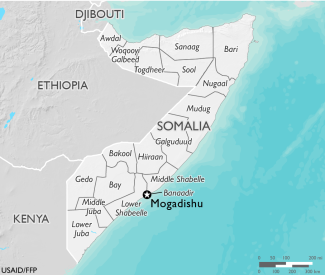April 30, 2020
Nearly three decades of political instability in Somalia have resulted in widespread insecurity, contributing to the internal displacement of an estimated 2.6 million people and leaving many Somalis highly vulnerable to climatic, economic, and security shocks. Somalia is also prone to natural hazards, particularly drought and floods, which have led to recurrent food and nutrition crises.
Situation
- Despite above-average crop output and improved livestock production following favorable October-to-December deyr rains, the Famine Early Warning Systems Network (FEWS NET) projects that the total number of people in Somalia experiencing Crisis—IPC 3—or higher levels of acute food insecurity will increase from the February estimate of 1.2 million to more than 1.6 million during the June-to-September period. These projections are based on anticipated desert locust-induced crop and pasture losses, seasonal April-to-June gu flooding, and the reduced ability of poor households to cope with shocks and agricultural losses. Additionally, FEWS NET reports that approximately 963,000 children younger than five years of age will likely experience acute malnutrition through December 2020.
- Food insecurity in Somalia may also be exacerbated by the impact of the coronavirus (COVID-19) pandemic on domestic market supply chains and household food and income sources. In particular, household income from remittances will likely diminish as economic activities in source countries decrease due to COVID-19, according to the UN Office for the Coordination of Humanitarian Affairs (OCHA).
- While the effect of desert locusts remains limited and localized as of April, new swarms of desert locusts pose a risk to food security over the coming months, particularly in northern Somalia and in south-central areas along the borders of Ethiopia and northeastern Kenya. The Food Security and Nutrition Analysis Unit for Somalia (FSNAU) estimates that desert locusts could potentially damage up to 19,000 metric tons of crops produced during the spring to summer harvest—an amount of food sufficient to support an estimated 281,000 people for six months. Though above-average rainfall in the April-to-June gu rainy season is expected to support pasture regeneration and planting activities, partially offsetting the impact of desert locusts, gu rains could also enable a new wave of breeding and worsen the spread of locusts.
*The Integrated Food Security Phase Classification (IPC) is a standardized tool that aims to classify the severity and magnitude of food insecurity. The IPC scale, which is comparable across countries, ranges from Minimal (IPC 1) to Famine (IPC 5).
Response
- USAID’s Office of Food for Peace (FFP) supports the UN World Food Program and other relief organizations to provide assistance to food-insecure people in Somalia, primarily through cash transfers for food and U.S. in-kind food aid. Analysis by FEWS NET and FSNAU indicates that food assistance from FFP and other donors is preventing worse food security outcomes in many areas of the country.
- FFP also provides funding to prevent and treat acute malnutrition in Somalia. In 2019, nutrition actors treated over 647,000 Somali children younger than five years of age with acute malnutrition, including approximately 252,000 children suffering from severe acute malnutrition.
Food for Peace Contributions
Total Contributions:
| U.S.Dollars | Metric Tons | |
| Fiscal Year 2020 | $13.8 million | 40,265 MT |
| Fiscal Year 2019 | $303.7 million | 90,486 MT |
| Fiscal Year 2018 | $258.4 million | 77,347 MT |
* Metric tonnage does not reflect funding for vouchers or cash transfers.
Related Resources

